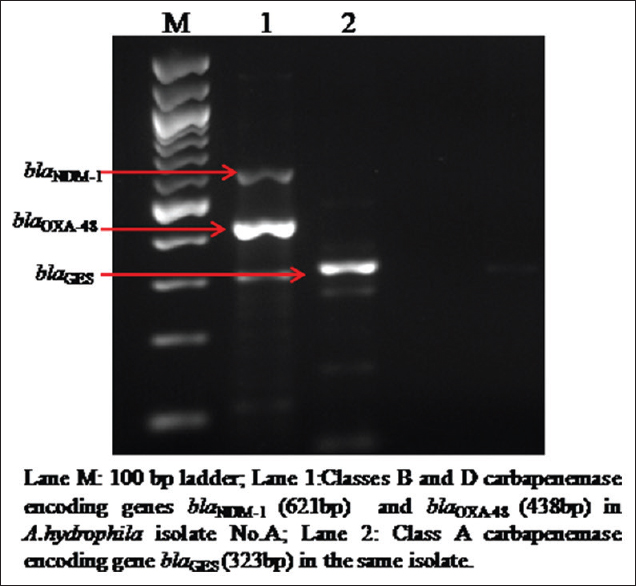Translate this page into:
Emergence of Aeromonas spp. Harboring Multiple Carbapenemase-encoding Genes from Hospital Sewage
Address for correspondence: Dr. Tuhina Banerjee, E-mail: drtuhina@yahoo.com
This is an open access article distributed under the terms of the Creative Commons Attribution-NonCommercial-ShareAlike 3.0 License, which allows others to remix, tweak, and build upon the work non-commercially, as long as the author is credited and the new creations are licensed under the identical terms.
This article was originally published by Medknow Publications & Media Pvt Ltd and was migrated to Scientific Scholar after the change of Publisher.
Sir,
In January 2016 issue of the journal, an excellent review on Aeromonas spp.[1] as an emerging pathogen has been published emphasizing the importance of this enteric pathogen. We have also recently experienced the increasing prevalence of this organism in our hospital environment. A study was carried out to determine the prevalence of various enteric pathogens in hospital sewage of a tertiary care center in Varanasi, North India. Samples from 22 different sites were collected as previously described,[2] and sewage samples were processed by membrane filtration method. Colonies of Aeromonas spp. were isolated on MacConkey agar and isolates were biochemically identified[2] and type species were confirmed by 16sRNA-based polymerase chain reaction (PCR) and sequencing. Antimicrobial susceptibility testing was performed as per the Clinical and Laboratory Standards Institute[3] and isolates were screened for the presence of carbapenemase genes by PCR (blaGES, blaIMI/ NMC-A, blaSME, blaKPC, blaIMP, blaVIM, blaOXA-48, blaNDM).[4]
A total of seven Aeromonas isolates were identified from seven different sites comprising four isolates of Aeromonas caviae and three isolates of Aeromonas hydrophila. The antimicrobial resistance profile of the isolates was 28.57% resistance to cefuroxime, 28.57% to ceftriaxone, 28.57% to cefepime, and 42.85% to levofloxacin. All except one (No.A) isolate were susceptible to carbapenems, namely, imipenem and meropenem by disc diffusion method. However, this isolate No.A harbored the blaNDM-1 and blaOXA-48 along with blaGES carbapenemase genes [Figure 1].

- Polymerase chain reaction amplification of carbapenemase-encoding genes
It has been stated that the carriage rate of Aeromonas in human gut varies from 0% to 4%.[1] However, their increased isolation in hospital effluents which provides an excellent media for genetic exchange, being enriched with selective antibiotic pressure, is a threat to their emergence as virulent enteric pathogens. A few reports of blaKPC-positive Aeromonas carriage in stool have been recently reported.[56] In this case, isolate-harboring multiple carbapenemase-encoding genes simply accelerate the evolution of antimicrobial resistance in these pathogens.
Financial support and sponsorship
Nil.
Conflicts of interest
There are no conflicts of interest.
REFERENCES
- Distribution and survival of motile Aeromonas spp. in brackish water receiving sewage treatment effluent. Appl Environ Microbiol. 1991;57:2459-67.
- [Google Scholar]
- Clinical and Laboratory Standards Institute (CLSI). Methods for Antimicrobial Dilution and Disk Susceptibility Testing of Infrequently Isolated or Fastidious Bacteria; Approved Guideline. In: M45-A2 (2nd ed). Clinical and Laboratory Standards Institute: Wayne, PA; 2010.
- [Google Scholar]
- Multiplex PCR for detection of acquired carbapenemase genes. Diagn Microbiol Infect Dis. 2011;70:119-23.
- [Google Scholar]
- The route of antimicrobial resistance from the hospital effluent to the environment: Focus on the occurrence of KPC-producing Aeromonas spp. and Enterobacteriaceae in sewage. Diagn Microbiol Infect Dis. 2013;76:80-5.
- [Google Scholar]
- Detection of carbapenemase-producing Aeromonas hydrophila on perirectal surveillance culture. Open Forum Infect Dis. 2014;1(Suppl 1):S134.
- [Google Scholar]




